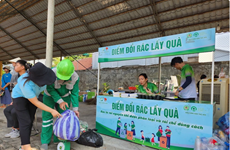Hanoi authorities advised tightening control over waste sources
 The habit of burning straw is causing smog in Hanoi, affecting the city’s environment and people’s health. (Photo:VNA)
The habit of burning straw is causing smog in Hanoi, affecting the city’s environment and people’s health. (Photo:VNA) Hanoi (VNA) – Hanoi needs to tighten control over waste sources and pushed up the application of environmental management to improve its air quality, said Hoang Anh Le, research team leader of the University of Natural Sciences under the Hanoi National University.
He gave the advice during a virtual workshop themed “Air quality management in Hanoi – pollution source and solution” held on June 30.
The workshop was jointly organised by the Centre for Living and Learning for Environment (Live and Learn), the Hanoi Department of Natural Resources (DONRE) and Environment in collaboration with the World Bank in Vietnam.
It offered opportunity for domestic and foreign experts, managers, businesses to share effective solutions to improve Hanoi’s environment.
Regarding fine dust emissions from burning rice straw in the city, Le said in 2021 winter-spring crop the amount of dry straw left in the fields was 1,936 tonnes and up to 43.2 percent of this amount was burned.
Pollutants from straw burning can spread through the air, affecting local people who don’t live near the burning site, he said, adding that the main polluted area located in the south of Hanoi namely Dai Nghia town (My Duc district), Van Dinh town (Ung Hoa district) and Kim Bai town (Thanh Oai district).
“It is necessary to strengthen inspection and supervision of waste sources, especially large waste sources. An automatic emission monitoring system and continuously transmit data to the DONRE for monitoring, he said.
He also emphasised the need to promote solutions to apply information technology on environmental management and develop environmental-management software for production and service establishments to strictly control air pollution.
Katelijn Van den Berg, a World Bank’s senior environmental expert, said that the highest PM2.5 concentration was measured on the days of biomass burning.
The concentration of organic carbon from biomass combustion accounts for 20 percent. Lead and tin-related industrial emissions account for about 10 percent of PM2.5 dust emissions. However, this source of emissions is partly mixed with other compounds of industrial origin.
In order to improve air quality, World Bank experts suggested the city's authorities create a mechanism to encourage businesses to apply clean production models.
In addition, agencies and localities need to strengthen control of air pollution caused by industrial activities, supervise and strictly punish violations of regulations on environmental protection. The construction of advanced waste treatment plants should be sped up and tree planting should be promoted at the same time.
Participants at the workshop proposed that in the coming time, Hanoi should tighten control over transportation activities, checking the emissions of vehicles and banning the ones that don’t meet the emission standards.
It was essential for the city to quickly develop public transport network to restrict private vehicles in downtown and accelerate the relocation of universities and offices out of the inner city to reserve land for green space, they said./












